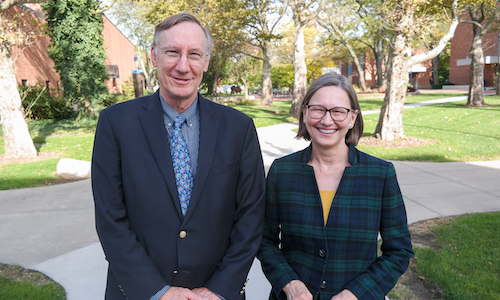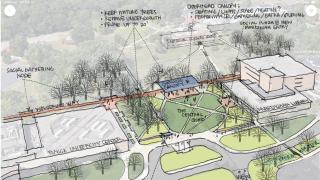
Back in February 2019, the University of Michigan announced its biggest ever sustainability goal: To be completely carbon neutral. Notably, unlike some past carbon reduction goals, which focused on the Ann Arbor campus, this one encompasses the entire University of Michigan system (including all its property around the world). Last week, as part of our Strategic Planning Thought Leader Series, Jennifer Haverkamp and Stephen Forrest, co-chairs of the President’s Commission on Carbon Neutrality, came to campus to talk about the plan and what it could mean for the UM-Dearborn campus. We’ve broken down the major takeaways from their visit, in case you missed it.
So what does “carbon neutrality” actually mean?
Carbon neutrality involves achieving net-zero carbon emissions by balancing the amount of carbon that’s emitted into the atmosphere with the amount of carbon that is absorbed from it. Importantly, carbon neutrality is about ensuring the numbers on each side of this equation match — and doesn’t require eliminating all sources of carbon. For example, people, companies and institutions often buy “carbon offsets” to help them achieve carbon neutrality. This typically involves investing in emission-reducing projects (like wind farms) or emission-absorbing projects (like reforestation). To take a simple example, if you drive a gasoline-powered vehicle, you could offset your carbon emissions by planting (or paying someone else to plant) enough trees to absorb the same amount of carbon. In this way, you’re still a source of emissions, but the atmosphere is receiving no additional net carbon.
How does U-M plan to get to net-zero emissions?
Importantly, while many large institutions rely heavily on the purchase of carbon offsets to reach this net-zero balance, U-M plans to only use offsets when they are completely necessary. Instead, U-M will be doing an extremely comprehensive internal analysis of all its carbon emissions and figuring out ways to reduce or eliminate them. This could involve things like improving energy efficiency and reducing energy waste from existing buildings; aggressively reducing transportation emissions from commuters and busses; changing building standards for construction of new buildings; purchasing electricity from renewable sources; creating a more sustainable model for food services; and investing in biosequestration projects, particularly on university-owned property. In some limited cases, like university-sponsored air travel, offsets may still be required.
So what could that mean for UM-Dearborn?
Forrest and Haverkamp say the path to carbon neutrality will require different actions on every U-M campus. Energy efficiency, waste reduction and electricity purchasing will be a big part of what happens on all three campuses. Notably, however, UM-Dearborn is almost exclusively a commuter campus, and it’s likely that a large share of its carbon footprint is comprised of transportation emissions from students, faculty and staff. Reducing those emissions can be quite challenging, since they come from many private, individual sources over which the university has no direct control. Investments in public transportation and programs that incentivize carpooling or electric vehicles are steps that can reduce emissions, though offsets may still be necessary. For example, at Appalachian State University, where commuter emissions make up 13 percent of the university's carbon footprint, commuter offsets can be purchased along with a parking pass. They cost $8.
This is bigger than U-M.
What happens at U-M hardly has to stay here, according to Haverkamp and Forrest. As a research-focused institution with hundreds of scholars and staff already working in this field, U-M is far better positioned to come up with the innovative processes and technology needed to get to net-zero. And what we discover could help hundreds of other colleges, universities, companies and cities reach their own carbon neutrality goals. Thus, the university's work could have reverberations around the world.
What happens next?
Things are moving fast. Haverkamp and Forrest have only been co-chairing the President’s Commission on Carbon Neutrality for six months, and already an army of committees and working groups are tackling particular aspects of the challenge. One year from now, the commission will present a final report with recommendations for achieving carbon neutrality. Your participation is still vital, Forrest says. You can send your ideas for reducing carbon emissions directly to the commission via their website. And there are a number of opportunities for students to get involved, including research assistantships and still-open spots for UM-Dearborn students on the commission's student advisory panel.
###
Want to learn more about the push to make U-M a carbon-neutral university? Check out the website of the U-M President's Commission on Carbon Neutrality.





